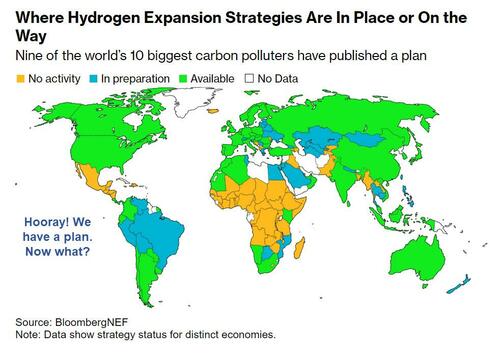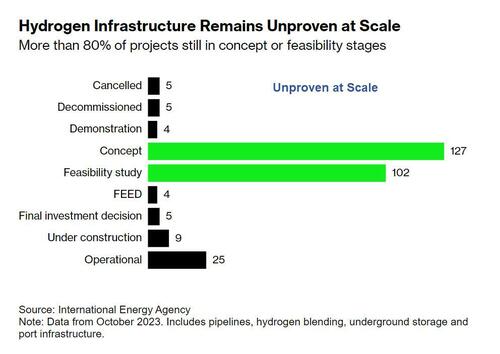Authored by Mike Shedlock via mishtalk.com,
I’m all in favor of hydrogen-powered plants to produce electricity if only we had cheap hydrogen. But we don’t and likely won’t.
A Bad Bet on Hydrogen Hype
Bloomberg cautions Europe’s Spending Billions on Green Hydrogen. It’s a Risky Gamble
Today, the bright yellow power plant tucked behind a graffiti-covered fence burns planet-warming gas to produce electricity. But if all goes to plan, it will one day switch to emissions-free hydrogen. It’s the first, tiny part of a dream energy system being sketched out by policymakers across Europe, who are banking on the green fuel to meet some of the world’s most aggressive climate targets. That dream rests on converting newly built polluting infrastructure to burn hydrogen, a fuel that’ll be many times more expensive than natural gas and that no one has figured out how to move safely and cheaply in bulk.
Governments and companies that are racing to meet net-zero deadlines but worried about energy security can still build billions of dollars worth of gas infrastructure as long as it’s “hydrogen-ready.” Nine of the world’s 10 biggest carbon polluters have published hydrogen strategies and incentives to grow the fuel’s use, which globally already exceed $360 billion, according to BloombergNEF.
Gas-dependent economies including Germany, the Netherlands, Spain, Italy and the UK are among Europe’s biggest proponents for using hydrogen and some have plans to use it to generate electricity. But there’s no official definition of what makes a plant hydrogen-ready, opening the door for greenwashing. For power plants, burning hydrogen hasn’t even been tested at scale.
“There has not yet been any measurable progress in the construction of hydrogen-ready, gas-fired power plants,” said Eric Heymann, an economist at Deutsche Bank Research.
Then there’s the problem of moving hydrogen around. The Leipzig plant isn’t hooked up to the grid (and hasn’t yet set up its own electrolyzers), which means the highly combustible fuel will have to be trucked in until the second part of the government’s grand plan comes to fruition. It’s building a €1 billion liquefied natural gas terminal in Brunsbuettel, a town along the North Sea, that will initially import LNG but be designed to also handle futuristic clean fuels.
Hydrogen can only be liquefied at -253C (-423F), well beyond the capabilities of today’s LNG ships. So Germany is planning to import hydrogen in the form of liquid ammonia, a combination of hydrogen and nitrogen that can more easily be turned into a liquid. But ammonia is toxic and handling requires better ventilation systems. Many components in the terminal, including control valves and fire and gas sensors as well as inline devices — most of which have not been tested with ammonia — will also need upgrades, according to Fraunhofer ISI, an energy think tank.
Not Viable But Full Speed Ahead
Germany doesn’t have an ammonia pipeline network and there are limitations to moving it via trucks on an industrial scale because it’s hazardous. That means ammonia will have to be converted back into hydrogen, yet there’s no economically viable technology currently available to do that. The terminal’s operator said it will discuss alternative strategies if none emerge by next year.
Wind and solar produce clean electricity — a commodity the world already uses. Green hydrogen, on the other hand, will require building more solar and wind farms when, in many cases, it would be simpler to just use that clean energy directly. By the time hydrogen is made, stored and burned to make electricity again, there’s nearly 70% less energy than at the start — and the cost has tripled.
Plans Only Exist On Paper
For the most part, the plans only exist on paper. That’s because they only work on paper.
A trial in the UK was cancelled when people made an uproar after learning they would have to replace their furnaces and stoves for new hydrogen appliances.
That does not apply to the situation discussed above which proposes burning hydrogen to produce electricity. However, there is a 70 percent loss of energy in the conversion from hydrogen to ammonia then back to hydrogen to burn it.
This makes no sense anywhere. Nonetheless, Germany is spending $20 billion to make electricity plants “hydrogen ready”.
Wasting $20 billion is a monthly occurrence in the Biden administration, but that’s a lot of money to Germany which unlike the US has budget rules.
China Shock
Germany is feeling the pinch of China shock. But the US is on deck too. A global trade war looms.
For discussion, please see China Shock II Is Coming, the EU Will Be Hit Hard, Then the US
Germany has too much else to worry about to waste money on absurd projects.
Authored by Mike Shedlock via mishtalk.com,
I’m all in favor of hydrogen-powered plants to produce electricity if only we had cheap hydrogen. But we don’t and likely won’t.
A Bad Bet on Hydrogen Hype
Bloomberg cautions Europe’s Spending Billions on Green Hydrogen. It’s a Risky Gamble
Today, the bright yellow power plant tucked behind a graffiti-covered fence burns planet-warming gas to produce electricity. But if all goes to plan, it will one day switch to emissions-free hydrogen. It’s the first, tiny part of a dream energy system being sketched out by policymakers across Europe, who are banking on the green fuel to meet some of the world’s most aggressive climate targets. That dream rests on converting newly built polluting infrastructure to burn hydrogen, a fuel that’ll be many times more expensive than natural gas and that no one has figured out how to move safely and cheaply in bulk.
Governments and companies that are racing to meet net-zero deadlines but worried about energy security can still build billions of dollars worth of gas infrastructure as long as it’s “hydrogen-ready.” Nine of the world’s 10 biggest carbon polluters have published hydrogen strategies and incentives to grow the fuel’s use, which globally already exceed $360 billion, according to BloombergNEF.
Gas-dependent economies including Germany, the Netherlands, Spain, Italy and the UK are among Europe’s biggest proponents for using hydrogen and some have plans to use it to generate electricity. But there’s no official definition of what makes a plant hydrogen-ready, opening the door for greenwashing. For power plants, burning hydrogen hasn’t even been tested at scale.
“There has not yet been any measurable progress in the construction of hydrogen-ready, gas-fired power plants,” said Eric Heymann, an economist at Deutsche Bank Research.
Then there’s the problem of moving hydrogen around. The Leipzig plant isn’t hooked up to the grid (and hasn’t yet set up its own electrolyzers), which means the highly combustible fuel will have to be trucked in until the second part of the government’s grand plan comes to fruition. It’s building a €1 billion liquefied natural gas terminal in Brunsbuettel, a town along the North Sea, that will initially import LNG but be designed to also handle futuristic clean fuels.
Hydrogen can only be liquefied at -253C (-423F), well beyond the capabilities of today’s LNG ships. So Germany is planning to import hydrogen in the form of liquid ammonia, a combination of hydrogen and nitrogen that can more easily be turned into a liquid. But ammonia is toxic and handling requires better ventilation systems. Many components in the terminal, including control valves and fire and gas sensors as well as inline devices — most of which have not been tested with ammonia — will also need upgrades, according to Fraunhofer ISI, an energy think tank.
Not Viable But Full Speed Ahead
Germany doesn’t have an ammonia pipeline network and there are limitations to moving it via trucks on an industrial scale because it’s hazardous. That means ammonia will have to be converted back into hydrogen, yet there’s no economically viable technology currently available to do that. The terminal’s operator said it will discuss alternative strategies if none emerge by next year.
Wind and solar produce clean electricity — a commodity the world already uses. Green hydrogen, on the other hand, will require building more solar and wind farms when, in many cases, it would be simpler to just use that clean energy directly. By the time hydrogen is made, stored and burned to make electricity again, there’s nearly 70% less energy than at the start — and the cost has tripled.
Plans Only Exist On Paper
For the most part, the plans only exist on paper. That’s because they only work on paper.
A trial in the UK was cancelled when people made an uproar after learning they would have to replace their furnaces and stoves for new hydrogen appliances.
That does not apply to the situation discussed above which proposes burning hydrogen to produce electricity. However, there is a 70 percent loss of energy in the conversion from hydrogen to ammonia then back to hydrogen to burn it.
This makes no sense anywhere. Nonetheless, Germany is spending $20 billion to make electricity plants “hydrogen ready”.
Wasting $20 billion is a monthly occurrence in the Biden administration, but that’s a lot of money to Germany which unlike the US has budget rules.
China Shock
Germany is feeling the pinch of China shock. But the US is on deck too. A global trade war looms.
For discussion, please see China Shock II Is Coming, the EU Will Be Hit Hard, Then the US
Germany has too much else to worry about to waste money on absurd projects.



